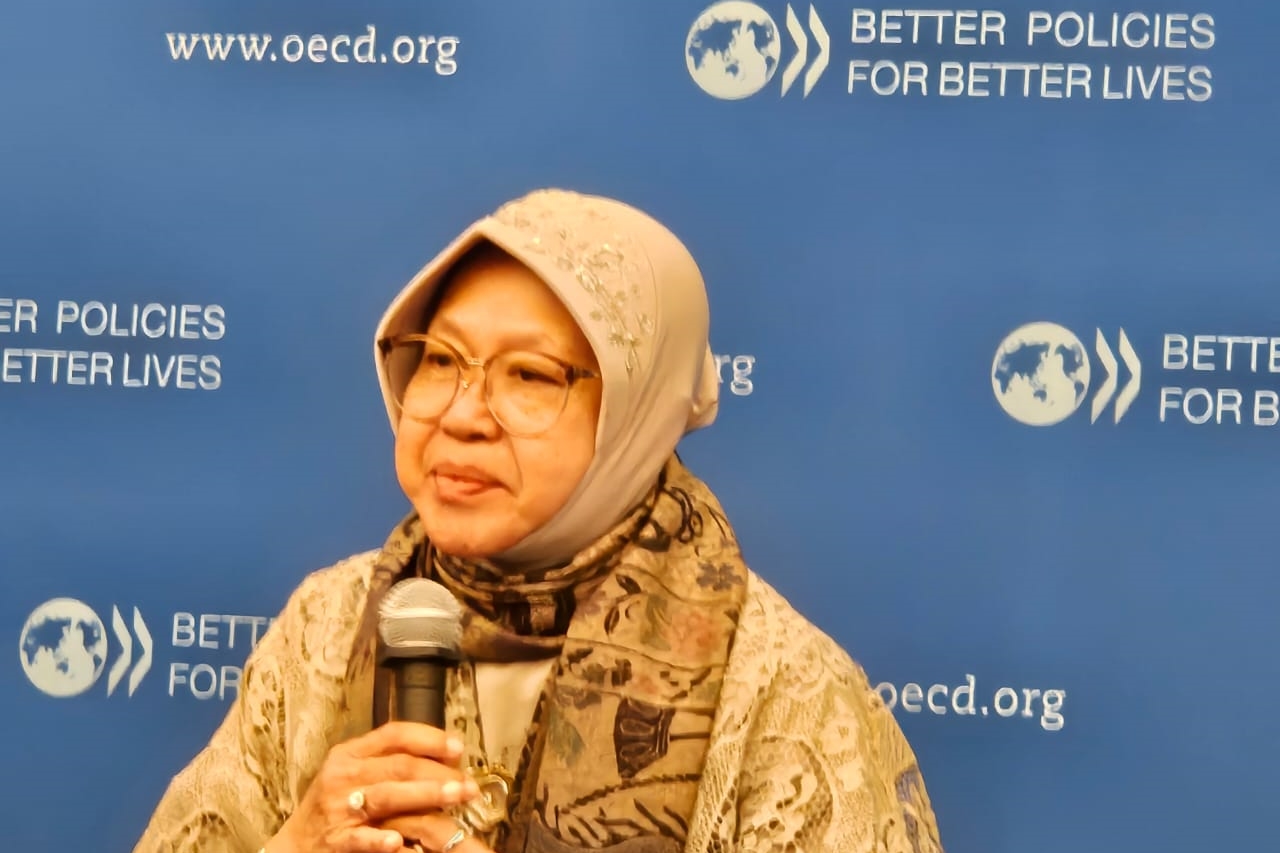Risma's Disaster Infrastructure Development Orientation Receives Appreciation from OECD Infrastructure Forum

PARIS (April 11, 2024) - The Infrastructure Forum of the Organization for Economic Cooperation and Development (OECD) on Wednesday afternoon (10/4) French time, held a discussion aimed at exploring effective mechanisms for involving communities and stakeholders in efforts to build infrastructure resilience.
Attending the discussion were four speakers, namely Indonesian Minister of Social Affairs Tri Rismaharini, Xavier Pelletier, Préfet (Province) of Loir-et-Cher, France, Grégoire Tirot, Inter-Ministerial Director for Public Transformation (DITP), France, and Barbara Minguez Garcia, Disaster Management at McAllister & Craig, also a World Bank Consultant. The moderator was Gillian Dorner, Directorate of Public Governance, OECD.
Infrastructure resilience was an important discussion given the recent trend of significant increase in natural disasters, such as floods, storms, landslides, earthquakes, and droughts/fires. Community involvement is an important issue because it is not easy to do according to experience in many countries.
On this occasion, Minister of Social Affairs Risma explained how disaster anticipation, handling during disasters, and post-disaster recovery in Indonesia are community-based. The Ministry of Social Affairs has trained and fostered more than 25,000 volunteers of Taruna Siaga Bencana (Tagana) or Disaster Response Volunteer from elements of the community spread throughout Indonesia. There is the Tagana Masuk Sekolah (TMS) or Tagana Goes to School program to train self-rescue, and evacuation, including dealing with earthquakes and tsunamis. There is a Disaster Preparedness Village (KSB) program to mobilize disaster preparedness in disaster-prone environments.
In addition, there are more than 49,000 social assistants who can help during disasters and in the recovery period after disasters. There are also 613 Social Barns in 328 districts/cities managed by the community to provide logistics needed by the community when a disaster occurs. In the social barn, there are supplies of food, clothing, tents, water tanks, water purifiers, and lighting equipment using solar energy. The logistics reserves are to anticipate isolation due to damage to transportation infrastructure.
Social Affairs Minister Risma also explained the example of handling the food crisis due to extreme cold weather in Central Papua and Papua Mountains, where the distribution of food aid was assisted by church communities and supported by the Indonesian National Army (TNI). In addition, there is a case study in Wini, East Nusa Tenggara, water infrastructure assistance in disaster areas managed by the community has succeeded in increasing their income, through planting sunflowers, as well as vegetables such as chilies and tomatoes.
All human resources (HR), such as Tagana and Social Assistance, which reach 74,000 individuals, are digitally connected to the Command Center. From the warning received from BMKG, it only takes 10 minutes for someone to receive instructions, and it only takes 30 minutes for HR who receive instructions at the disaster site to report the surrounding conditions accompanied by photos for decision-making at the Command Center. This digital technology solution has been implemented to complement and integrate with community-based solutions.
Social Affairs Minister Risma's answer surprised all participants when Gillian Dorner asked a critical question about what was the key to Surabaya's success as a disaster-resistant city when Risma became Mayor there, even though Surabaya is prone to flooding because its elevation is only 2 meters above sea level.
Risma explained that the ability of flood control infrastructure comes from community participation as environmental cadres in managing waste. By sorting and recycling in their communities, they have reduced Surabaya's waste in landfills to around 35 percent per day. This citizen participation, supported by city infrastructure development, made Surabaya a flood-free city at that time.
As Minister of Social Affairs, Risma has applied this community engagement experience to national strategies. To engage the community, it is important to understand what the community thinks to prioritize in handling disaster impacts. For example, when dealing with the impact of the earthquake in Padang, people did not want to leave their homes, because they did not want to leave their belongings.
Learning from this culture, the tents needed are those that are sized for families and are designed by themselves, not large tents that accommodate dozens of people. From the frequent earthquakes, Social Affairs Minister Risma designed her own earthquake-resistant house, which has become a model for post-earthquake housing assistance. It is hoped that the design of the earthquake-proof house can be imitated by the surrounding community as a form of earthquake anticipation.
The Minister's answer has been noted as the conclusion of the discussion that infrastructure recovery should not only be planned in a top-down manner but also take into account what the community has in mind (bottom-up). And, interestingly, a Minister at the national level has gained complete experience at the local level.
Barbara agreed with Minister Risma's strategy
and confirmed it with her experience as a World Bank consultant in various
countries. Gillian closed with a statement that infrastructure must be
citizen-oriented, exactly the same orientation that Risma has implemented in
the Ministry of Social Affairs.
 English
English
 Bahasa
Bahasa
